Last Updated on March 30, 2023
Buying a new featherbed can be confusing.
You might have heard that you should be using one. Or maybe you’ve discovered that feather beds are the reason why hotel beds are so comfortable.
Either way, you’d like to purchase one now, but maybe you aren’t too sure where to start?
That’s completely normal, and it’s a confusion shared by most first-time featherbed buyers. But finding a good featherbed doesn’t have to be challenging.
You just need to know which features are important, and what to look for.
Let’s break it all down, and then put the puzzle back together again.
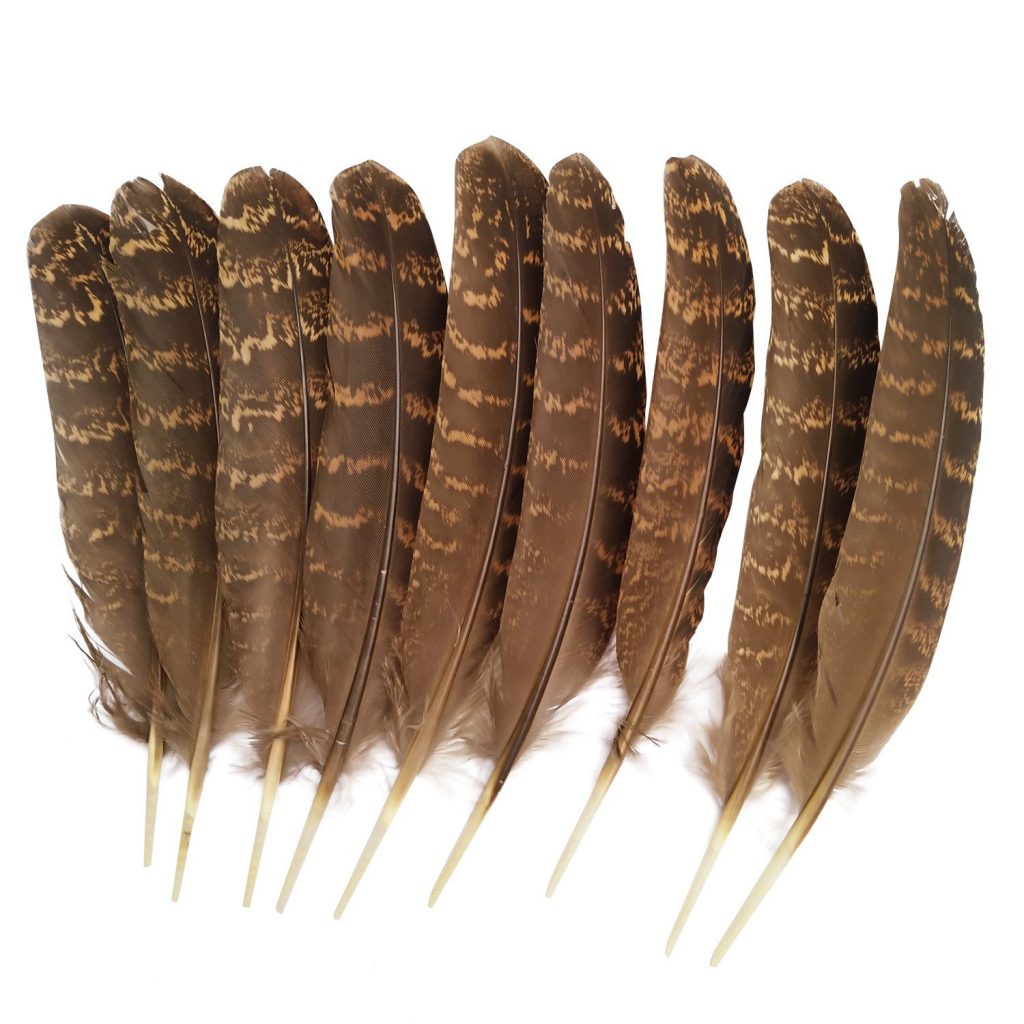
Which features of a featherbed are important?
A featherbed is just a huge pillowcase filled with feathers – that’s all that it is. But not all feather beds are equal.
The most common advice that you’ll find is something generic like “buy something well-made”. But how do you know if a featherbed is well-made?
Finding a good feather bed then, boils down to 4 important factors:
- Outer fabric
- Construction
- Baffling type
- Feathers
If you can find quality in those 4 areas, then you have a winner. Our preference is the Pacific Coast Hotel featherbed.
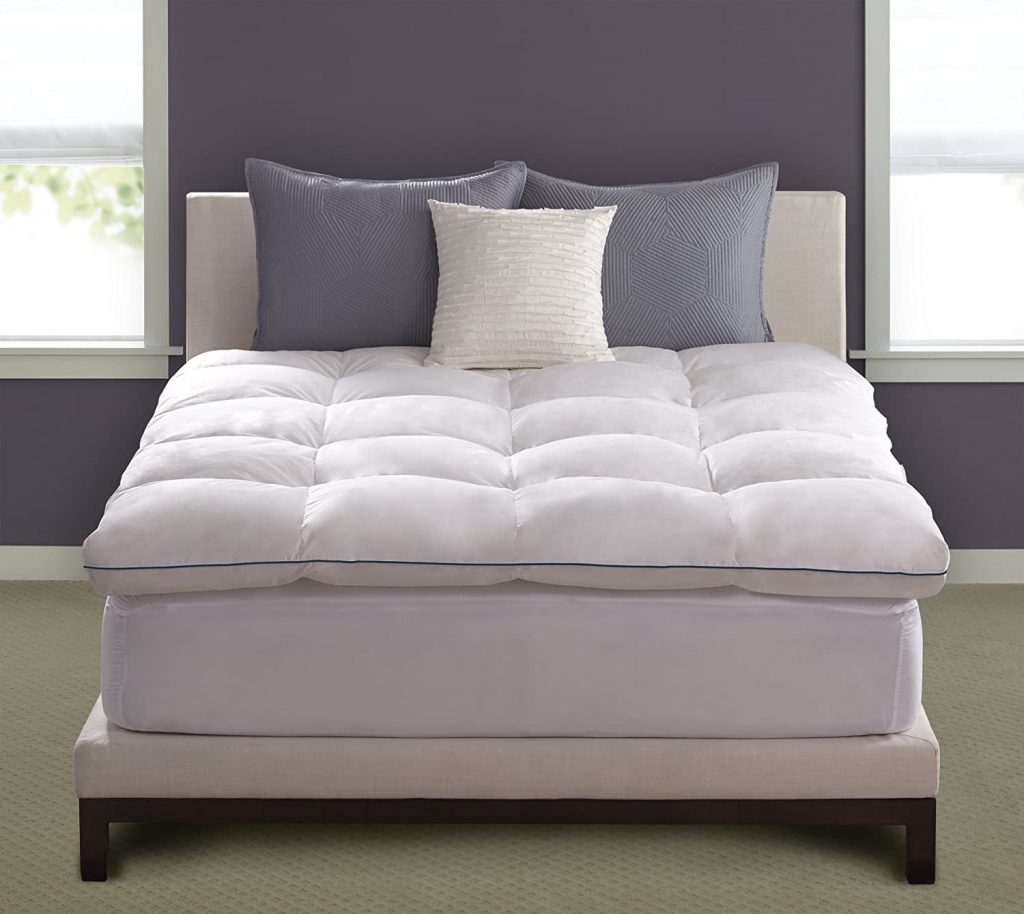
Why is the Hotel Featherbed our preference?
It’s certainly a “luxury model”, but that isn’t why. The Hotel featherbed from Pacific Coast features quality construction, uses the right materials, and has the best feathers available.
These are the same featherbeds from Ritz-Carlton hotels!
Whichever featherbed that you ultimately decide to buy, look out for features like the ones outlined above, and explained below.
The fabric of the outer cover
A common problem that cheaply-made featherbeds suffer from is leakage of feathers. That comes both from the fabric, as well as the construction (which we will address in the following section).
A leaked feather or two from time to time isn’t a big deal – but it can be a nuisance when it turns from an occasional occurrence to a frequent one.
Over time, the leaked feathers add up, and your once plump featherbed turns into a deflated mess.
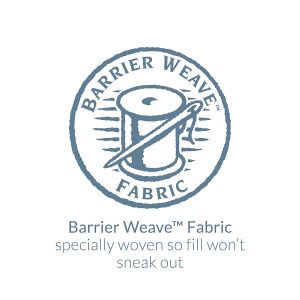
What you want to see is a cover made of 100% cambric cotton (usually 230 thread count). Cambric cotton produces a tight weave that doesn’t allow the quill end of feathers to poke through.
Don’t worry about the thread count, the design, etc. Your featherbed will be out of sight, and you’ll never actually feel the thread count, or see the design (if any).
The Hotel featherbeds, for example, feature Pacific Coast’s Cambric cotton “Barrier Weave” fabric.
The construction
As far as construction is concerned, our primary focus is how the featherbed is put together – specifically the sewing.
The outer cover of a featherbed is essentially two flat sheets sewn together. Pay attention to the edges of the featherbed. What does the seam look like?
Cheaply produced featherbeds will have seams that feature a simple stitch – which commonly breaks apart, or comes undone after even a few years of use.
A small opening is enough for a large number of feathers to escape.
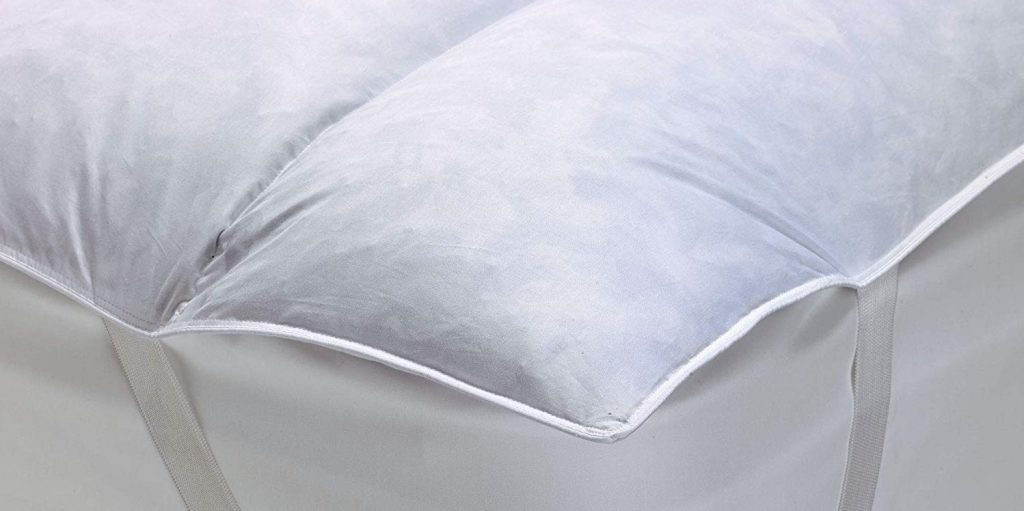
What you want to see is a defined edge. Quality construction will feature knife-edge seams or piping along the edges. The picture above is an example of a knife-edge seam.
A true edge will hold itself together, and withstand the use and abuse associated with using and maintaining a featherbed for a number of years. A quality sewn edge will not come apart, and won’t leak feathers.
The Hotel feather beds we spoke about earlier feature double-needle sewn selvages, and all-around piping.
The piping is that line of navy blue that you see running from edge to edge.
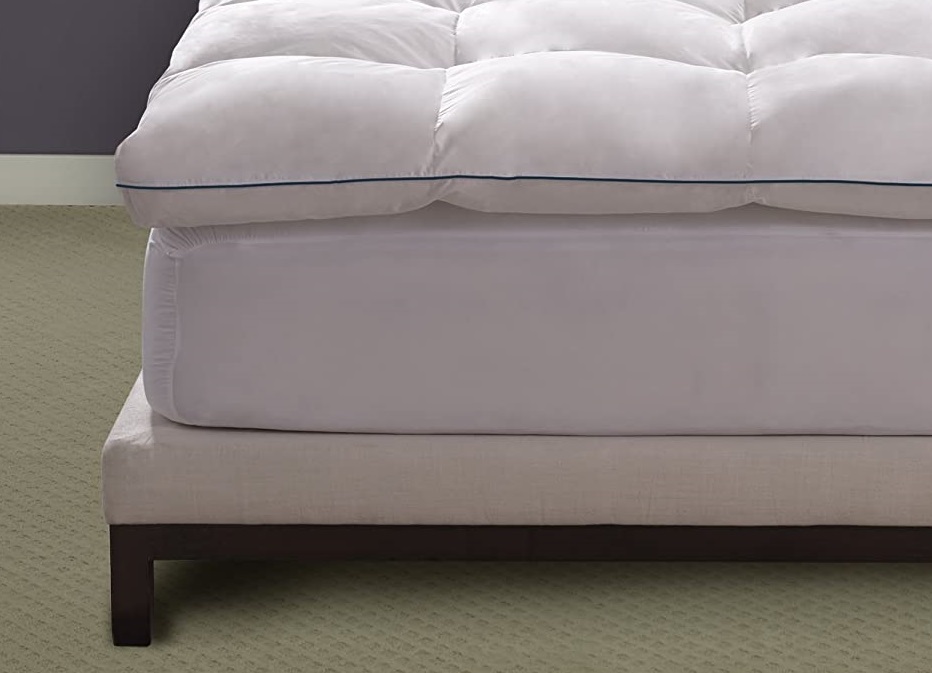
The baffling type
When you look at a featherbed, it looks very much like a comforter. It is quilted into a number of different sections – or “baffled boxes”.
The purpose of baffling a featherbed is to keep the fill evenly distributed. Without baffles, for example, the feathers clump in one section, leaving you with some very high, and some very low spots.
The most common type of featherbed is the baffled box type, like the one below:
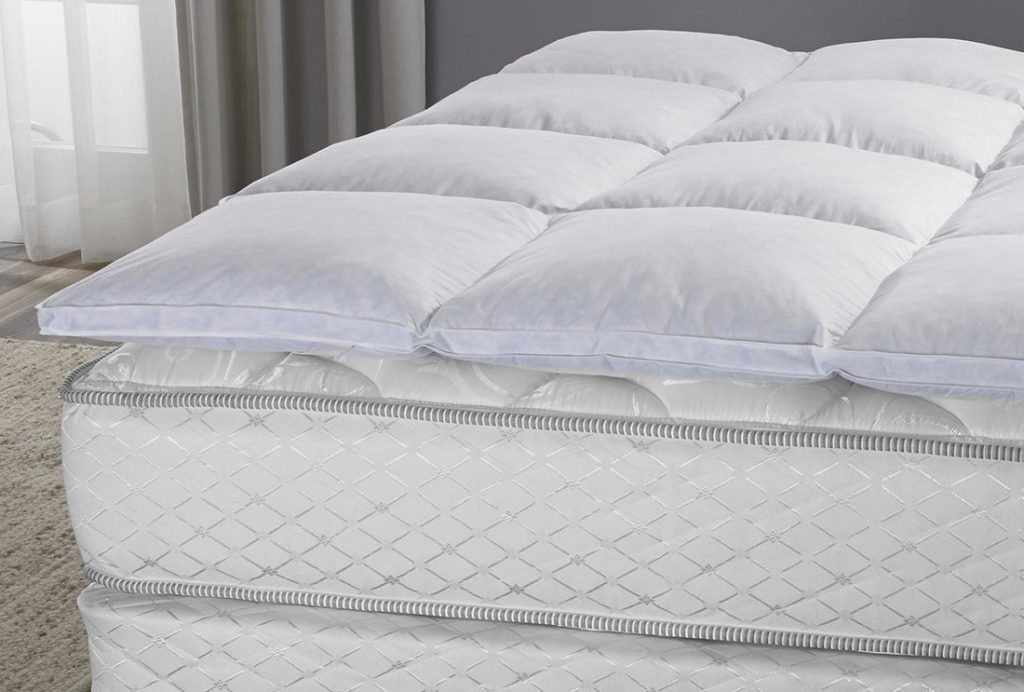
This type of baffling does a very good job, but the squares tend to peak in the middle. The end result is a bit more springy rather than fluffy.
The individual boxes are not very big and do not allow for much feather wiggly room.
Pacific Coast’s Hotel featherbed features 3-D fabric boxes. This provides extra space for the feather fill and creates a fluffy surface feel.

The feathers
If you don’t suffer from an allergy to feathers or goose down, you can probably skip this section. But if you do, or if you think that you might, keep reading.
If you suffer from feather allergies, there is some good news for you.
The feathers used in featherbeds, for example, are mass processed. Cheaply-made featherbeds use cheaply-sourced feathers. These are the types of feathers that cause allergies.
Allergies aren’t caused by the feathers themselves, but rather the allergens contained within them.
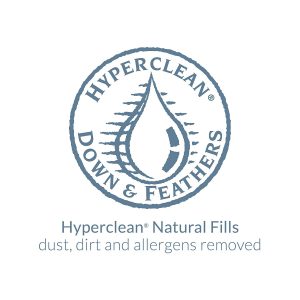
A quality featherbed will not cause allergies, because it will be filled with sanitized feathers.
For example, Pacific Coast’s Hotel featherbed which we referenced above features hyperclean Resilia feathers.
Resilia feathers receive a sanitizing treatment to remove any contaminants trapped within the feathers, making them virtually allergy-free.
A quick word about maintenance
Properly maintaining a featherbed can be tricky, and expensive!
They are simply too large to fit inside of a regular washing machine at home, which means that you’ll have to take them to a dry cleaner.
Which is both pricey and inconvenient.
A better option is to avoid washing it, by using a feather bed protector.
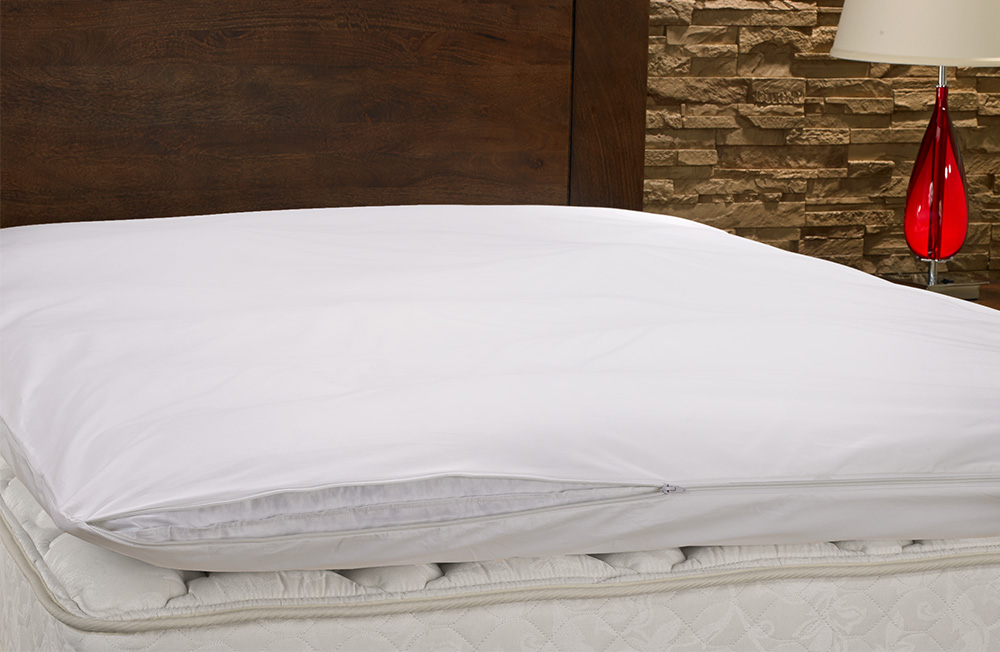
Featherbed protectors are very affordable and will save you a ton of money in dry cleaning bills.
They will keep your featherbed clean and looking like new for years – which means that you’ll pretty much never have to wash it.
There’s also one more reason to use a featherbed protector. They also keep the bugs out!
Dust mites and bed bugs, of course, love to feast on feathers. After a few years, they turn the feathers into a fine mush and deflate your featherbed.
A protector will keep the bugs out – and will keep any escapee feathers in.
Final thoughts
Keep in mind that feathers shouldn’t have any odor. If you’re experiencing what seems like a “feather odor”, it’s because your feathers are wet or damp.
Place your featherbed in a warm area for a few hours to let it thoroughly dry out before placing it back into your bed.
